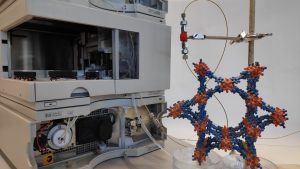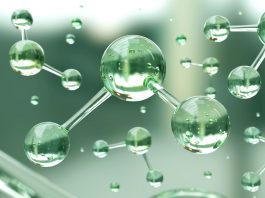Scientists at the Karlsruhe Institute of Technology (KIT) create stabilising enzymes that can be used in both aqueous and organic solvents.
When used as biocatalysts, enzymes accelerate many chemical reactions. At the Karlsruhe Institute of Technology (KIT), researchers have now embedded enzymes in metal-organic cages (MOFs) for the first time.
They then demonstrated that stabilisation by these frameworks is sufficient for use of the enzymes in a continuous reactor. Moreover, the enzymes embedded in the MOFs can be used in both aqueous and organic solvents.
The uses of enzymes
Enzymes are considered true multi-functional talents. They accelerate many chemical reactions as catalysts. In organisms, they are involved in vital processes. In technology and industry, they can be used as tools of white biotechnology and help save energy and resources. Enzymes in detergents, for instance, detach dirt at low temperatures. Enzymes are also applied in environmental technology, food processing, medicine production, medical diagnostics, and many other branches.
However, enzymes are primarily represented in proteins. To use the potential of these huge molecules in so-called ‘cell-free biotechnology’, they must be stabilised and integrated in efficient reactor systems. This has already been achieved in aqueous solvents. In organic solvents, by contrast, the destabilisation or denaturation occurs, and catalytic properties are lost as a result.
Researchers from KIT’s Institute of Functional Interfaces (IFG), Institute of Nanotechnology, and Institute for Biological Interfaces 1 – Biomolecular Micro- and Nanostructures have now succeeded in stabilising enzymes such that they can be used in both aqueous and organic solvents. For the first time, they demonstrated a continuous enzyme reactor system of high productivity and stability. This is reported in the journal Angewandte Chemie.

3D model of a MOF in front of the enzyme-MOF flow reactor at the laboratory of KIT’s Institute of Functional Interfaces. (Photo: Dr. Raphael Greifenstein, KIT)
MOFs facilitate the separation of catalysts and products
The innovative reactor system is based on metal-organic frameworks (MOFs). These consist of metallic nodes and organic connecting rods and have crystalline structures with defined pore sizes. Using different combinations of metal building blocks and organic ligands as well as various pore sizes, MOFs can be customised for various applications.
In the case of cell-free use, enzymes act like cages. “We make the enzymes diffuse individually into the pores of the MOFs, that is they enter the cage voluntarily,” explained Professor Christof Wöll, Head of IFG. “The MOFs act as an armour and protect the sensitive biomolecules from denaturation.”
Due to the porosity of the MOFs, transport of reactants, i.e., of the substances consumed and products resulting during the reactions, can be better controlled. Moreover, MOFs facilitate complex separation of catalyst and products, says Professor Matthias Franzreb, Deputy Head of IFG and co-author of the study.
Stabilising Enzymes
KIT researchers demonstrated a time- and cost-efficient manufacturing process of an enzyme-MOF flow reactor. Stability of the immobilised enzyme was estimated 30 times that of the free enzyme. Catalytic activity reached about 30% of that of a free enzyme – a high value in view of the deformation of the enzyme embedded in the MOF pores.
The study was made in connection with the Cluster of Excellence ‘3D Matter Made to Order’ of KIT and Heidelberg University as well as under the Helmholtz Program ‘Materials Systems Engineering’. In the future, MOFs will be modified with the help of computer-based methods such that deformation by the pores increases activity rather than reducing it.









